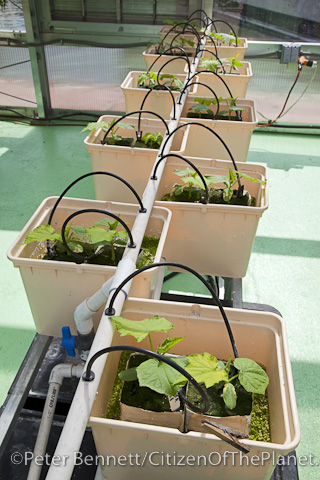The Science Barge
A few weeks ago I talked about the idea of converting urban rooftops into urban farms. The benefits go beyond just having more locally grown food, a reduction in transportation costs and mitigating the urban heat island effect, it helps people understand how food is grown, something too many of us have lost in a world of packaged foods, fast foods and ready to eat everything. But learning to grow a garden, let alone an urban farm can be a big jump for people. There is the issue of working in small, sometimes confined spaces, and how do you set up irrigation systems and get the energy to run them. These are challenges that got some people thinking a few years ago at an organization called New York Sun Works, and so they set out to create some prototypes for urban gardening that would help them and others understand how to create agricultural systems that work in an urban environment. They created the Science Barge.
The Science Barge was launched in May, 2007, and over the course of the next year or so, was moored at several spots along the Westside of Manhattan on the Hudson River. It is now run by Groundwork Hudson Valley and has found a permanent home in Yonkers. Visitors and schoolchildren are welcome to visit and learn about urban farming and sustainability, enabling them to create a vision for urban living that so far had been reserved for their rural neighbors, namely growing their own food. The barge is powered by two raised solar panel arrays, some micro wind turbines on the roof and bio-fuels. Water for irrigation is gotten from rainwater collected in a 1,200 gallon cistern, and Hudson River water that is run through a reverse Osmosis filter that purifies it for use.
The day I visited, I saw greens, lettuce, tomatoes and melons growing from a variety of Hydroponic and Aquaponic systems along with a few examples of vertical farming. Aquaponics is a bio-integrated food production system that is a combination of Aquaculture and Hydroponics, which basically means that the waste products of one biological system serve as nutrients for a second biological system. The first bio-system contain fish, the feces of which are broken down by algae in a second tank which then distributes the nutrients to the plants, the second bio-system. The plant system filters, cleans and recycles the clean water back to the fish in the first tank. The fish and algae create the nutrients the plants need, and the plants prevent a toxic build up of nutrients that would eventually harm the fish, essentially recreating a nutrient cycle normally found in nature.
Nearby was a table of greens being grown using the Nutrient Film Technique, a hydroponic system using a shallow stream of water containing nutrients that continually recirculates past the bare roots of the plants which are held in channels or gullies. There were also a series of plastic pots containing cucumber plants using another hydroponic system, a drip process call the Dutch Bucket system.
The Science Barge had over 3100 students visit last year as part of the barge’s formal education program. They also have a High School internship program that employs students from Yonkers. The general public can visit on weekends, here are their hours. Educating others on the benefits of urban farming is going on in many places around the country, including a number of Master Gardener Programs that bring this information directly to communities, but the Science Barge is a particularly assessable way to witness and explore this growing trend. The systems employed on the barge also happen to be high yield, and low impact as far as it’s carbon footprint, and maybe most importantly because it utilizes greenhouses, it is climate independent in that it can yield crops all year round. I keep saying it, but imagine a city of green roofs and greenhouses feeding the residents of the apartment complexes below them, what a site and what a step forward that would be.






